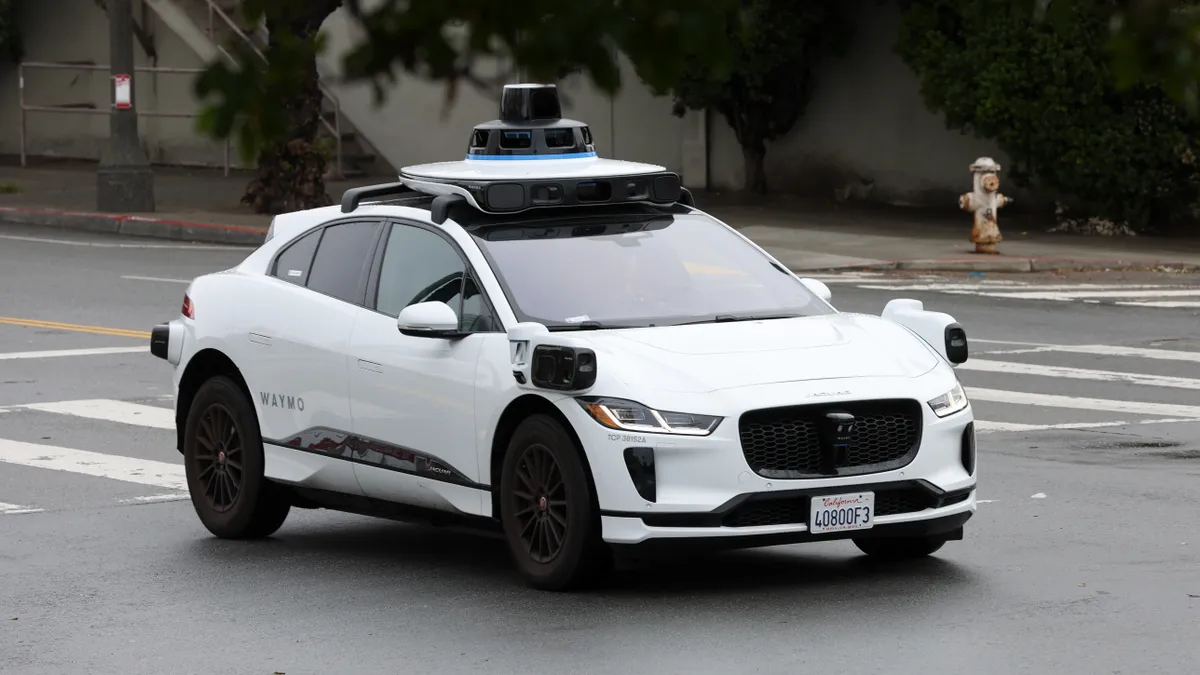Dive Brief:
- Waymo’s application to operate driverless robotaxis with paying passengers in Los Angeles and on the San Francisco peninsula received approval on March 1 from the Consumer Protection and Enforcement Division of the California Public Utilities Commission despite the objections of local authorities in both areas.
- Waymo, which already operates paid driverless robotaxi service in San Francisco and Phoenix, can begin service in the additional areas immediately following the CPUC’s determination that local officials’ objections do “not state proper grounds for protest.”
- The CPUC received letters in support of Waymo’s application from 81 organizations, including the American Council of the Blind, the California Bicycle Coalition and Mothers Against Drunk Driving.
Dive Insight:
Driverless robotaxis have a fraught history in San Francisco. Vehicles operated by General Motors’ Cruise subsidiary have been involved in crashes, stalled in traffic and blocked emergency vehicles. After a Cruise vehicle struck a pedestrian, pinned her under the car and dragged her 20 feet, the California Department of Motor Vehicles suspended Cruise’s operating permit in October.
Dozens of collisions involving Cruise and Waymo vehicles occurred in 2023, according to California DMV records. News reports cited situations last year in which Waymo vehicles blocked a fire truck, came to a prolonged halt in dense fog and stopped in a construction site when the vehicle encountered an open trench. Last month, a crowd attacked and set ablaze an empty Waymo vehicle in San Francisco’s Chinatown neighborhood.
Local leaders want more say in the deployment of driverless robotaxis in their cities. In a Nov. 1, 2023, letter from Los Angeles Mayor Karen Bass to the CPUC, Bass states that “local jurisdictions like Los Angeles have had little to no input in AV deployment and are already seeing significant harm and disruption.”
In a Feb. 13 meeting, the San Mateo, California, Board of Supervisors adopted a resolution in support of California Senate Bill 915, which would prioritize local control in the deployment of autonomous vehicles.
In an email to Smart Cities Dive, Waymo Communications Manager Sandy Karp wrote that “As always, we’ll take a careful and incremental approach to expansion by continuing to work closely with city officials, local communities and our partners to ensure we’re offering a service that’s safe, accessible and valuable to our riders.”
But Peter Finn, International Brotherhood of Teamsters western region vice president and president of Teamsters Joint Council 7, said in an email that the CPUC decision came less than a month after Waymo issued its first software recall in response to two of its self-driving cars striking a pickup truck being towed in Phoenix. “The fact that this permit is being granted following such a fiasco raises a lot of questions about the due diligence conducted during this process and how forthcoming Waymo is with both regulators and the general public,” Finn said.
The safety of autonomous vehicles remains open to debate. A study published by Waymo on Dec. 20, 2023, found that the crash rate of rider-only Waymo vehicles operated over 7 million miles was 85% lower than for vehicles operated by human drivers. However, the National Highway Traffic Safety Administration is investigating Cruise and since June 2021 has required automakers and operators to report crashes involving vehicles equipped with automated driving systems. As of May 15, 2022, NHTSA had received reports of 130 crashes, of which 108 involved no injuries.
“The lack of federal regulation on this new technology exposes everyone in AVs or on the roads with them to [the] risk of preventable crashes, injuries or death,” said Advocates for Highway and Auto Safety President Cathy Chase in an email. “Further, inadequate transparency and data collection hamper the ability of the public and policy makers to formulate well-informed and well-considered decisions.”
Nevertheless, robotaxi operators look to add or return to more cities. General Motors CEO Mary Barra said in January that the automaker remains committed to Cruise robotaxis. Bloomberg reported Feb. 22 that the company wants to return to public roads soon, with Houston and Dallas named as potential starting points. Cruise spokesperson Sara Autio told Reuters that the company’s “goal is to relaunch in one city with manually driven vehicles and supervised testing as soon as possible once we have taken steps to rebuild trust with regulators and the public.”












